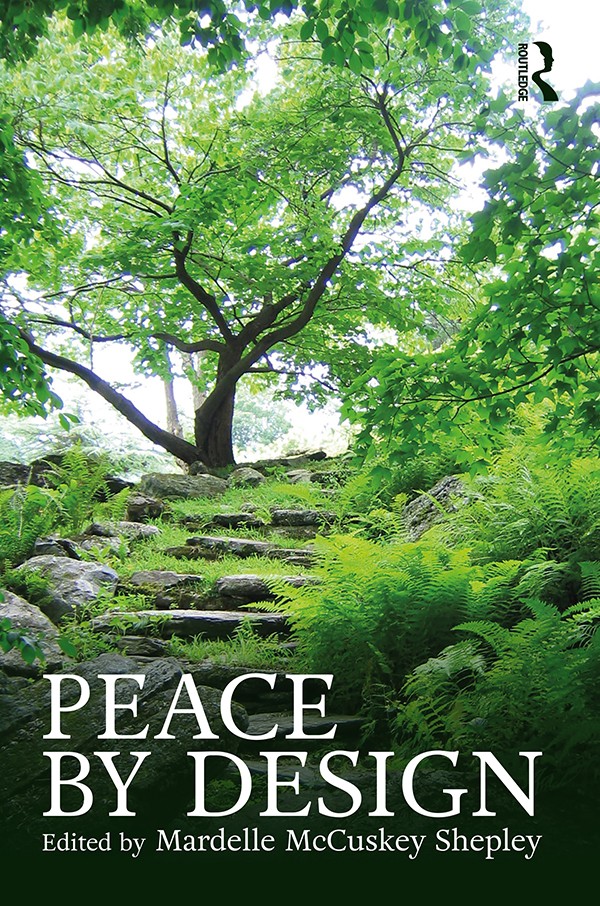Book explains how design can contribute to peace
By Marisa LaFalce
Lost cat painted on a stone by a homeless artist. The death of George Floyd. Graffiti quoting a social activist at the entrance to a green space.
These varied moments, experienced during the bleak early days of the COVID-19 pandemic, inspired Mardelle Shepley’s latest book, “Peace by Design.” The collection of essays by Shepley and other authors is intended for students, academics and practitioners in all design fields to inspire societal contribution and celebrate collaboration.
“I love my students, and I love design. This book is a thank-you letter to the many young designers I’ve worked with throughout my career,” said Shepley, academic director of the Cornell Institute for Health Futures (CIHF) and professor in the Department of Human Centered Design (HCD) in the College of Human Ecology. “The beauty that we impart through our love of one another is more important than anything we can build.”
Shepley’s research focuses on the impact of the physical environment on people’s mental and physical health. She wrote the opening and closing chapters of “Peace by Design” and invited experts from different design disciplines to contribute essays on designing products and processes that facilitate human well-being and personal and interpersonal peace.
In one chapter, Renata Leitão, assistant professor in HCD, highlights her work as a graphic designer and social justice-focused design researcher empowering Indigenous and marginalized communities. In another, Jay Yoon, assistant professor in HCD, discusses how designers can use human-centered design, positive psychology and persuasive technology to create products that enrich users’ emotional experiences.
Troy Savage, a project engineer and CIHF industry scholar, examines participatory innovation for reimagining possibilities. He recently worked with Shepley, Cornell students and Ithaca community members on reimagining the Ithaca Mall as a community wellness hub.
Together, the authors explore the power of design to contribute to peace at all scales, from combatting global climate change to building community gardens to personal action.
The College of Human Ecology spoke with Shepley about her book:
Question: What motivated you to write about peace?
Answer: We are in a world fraught with peril. I wanted to write a book that would contribute to mental wellness and hope. As I’ve matured, I’ve become a better problem solver. I see this book as a strategy for solving some of the challenges in this world.
Promoting environmental healing, reducing gun violence and accepting responsibility for health and social and racial equity have one thing in common: They can contribute to a more peaceful world.
The tenets of design justice and sustainable design can stimulate social responsibility. Social responsibility is foundational to policies and environments that support health and well-being, which in turn impact personal and interpersonal peace.
Q: What do you hope that people will take away from this book and why is it relevant today?
A: This book is less technical than many of my previous books. It is my hope that a young designer might carry it in their backpack and read it on the subway, to be reminded of their power as designers, to inspire their purpose and contribute to society by raising people up.
I teach a class in Design Accountability. The premise of the class is that we need to be responsible for the impact of our designs. Did our work meet a need? For young people trying to find their purpose, this is a possibility. A way to feel good about the work that they do and to accomplish change.
Q: You write that George Floyd’s death was one of the catalysts for writing this book. Tell me about your research regarding gun violence and environmental design.
A: When I see violence in this world, I often think, what can I do as a designer to mitigate it?
Several years ago, I embarked on a systematic review of the design literature with two former students. The evidence was striking. Access to green space may lower the incidence of gun violence.
Since that paper was published, the subject continues to receive more research. More study is needed to understand why green space has such a profound and positive effect on crime reduction. Is it stress reduction? Lower heat index? Improved air quality?
I hope that this book inspires designers to ask how we might use our training to address these and related issues to promote human well-being.
Q: How did you choose the chapter authors and essayists for this book? What do you hope readers will gain from this transdisciplinary lens?
A: Most of these writers have had a personal and profound connection on my life.
They are external collaborators, former students and colleagues from the Department of Human Centered Design.
This breadth of design fields and the collective authorship were an intentional decision to be harmonious with the thesis of peace. I have tried to be inclusive at every scale from font selection to amplifying less-published voices.
Marisa LaFalce is a communications assistant for the College of Human Ecology.
Media Contact
Get Cornell news delivered right to your inbox.
Subscribe

